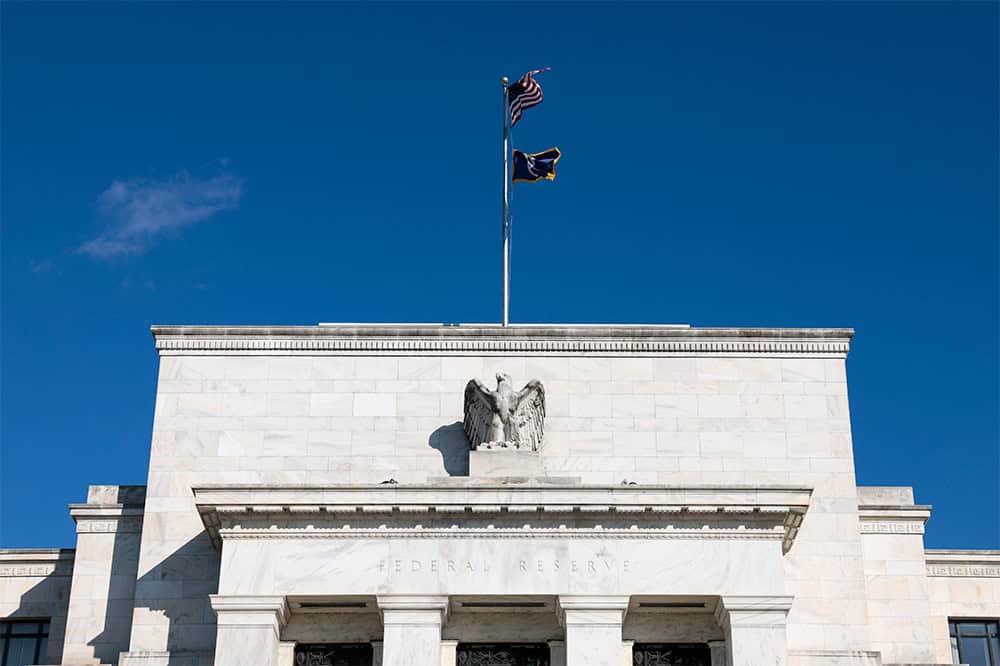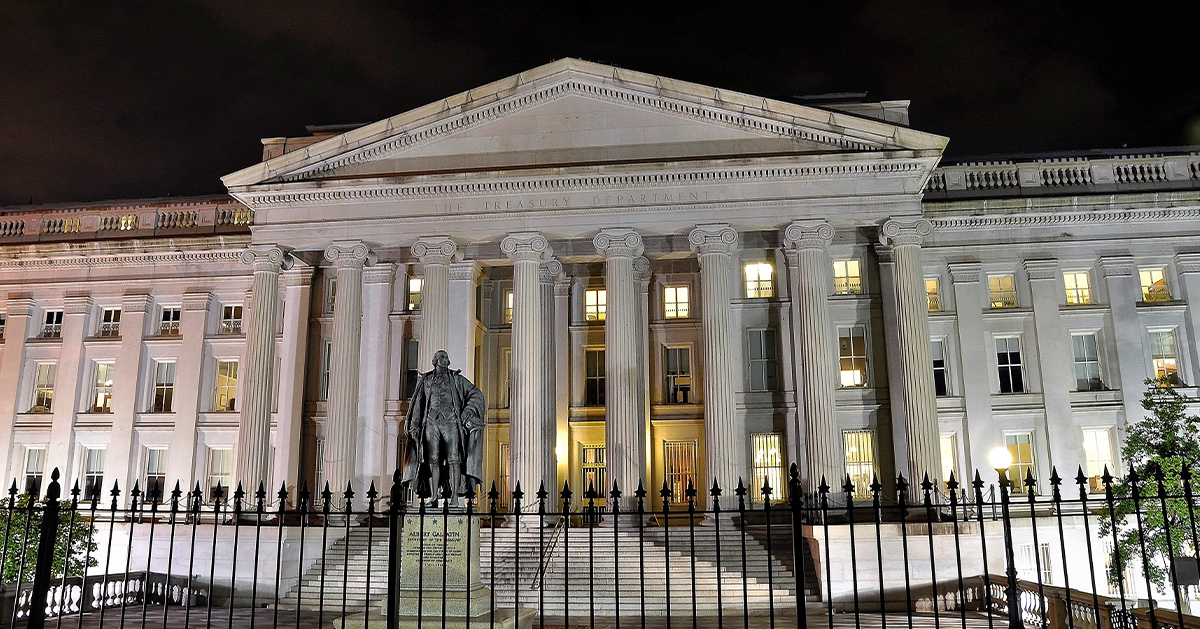Every year, the Congressional Budget Office (CBO) publishes updated projections to its 2019 Long-Term Budget Outlook. This year’s update, released this week, confirms that America remains on an unsustainable fiscal path, which threatens our future economy.
CBO projects that if current laws remain in place, federal debt will rise to 144 percent of gross domestic product (GDP) within 30 years — far exceeding its all-time high, and nearly doubling today’s level. If certain existing costly policies are extended, debt could rise even higher — to 219 percent of GDP under an alternative fiscal scenario.
Unless policymakers act, CBO concludes that rising debt could reduce future economic growth and income, crowd out private investment, create constraints for policymakers to respond to unforeseen events, and raise the risk of a fiscal crisis. This dangerous path of federal debt remains a critical issue for our future, and changes to spending and tax policies are necessary to put the nation on a sustainable path.
CBO’s report highlights the need to address our fiscal future:
“The prospect of such high and rising debt poses substantial risks for the nation and presents policymakers with significant challenges.”
In the new report, CBO finds that:
- Federal debt is already at its highest level as a percentage of GDP since 1950 and would exceed its all-time high by 2037 under current law. The outlook would be even worse if lawmakers choose to extend recent tax cuts and continue existing levels of spending.
- The large amount of debt is the result of a structural imbalance: spending growth (which is fueled primarily by the aging of the population, increasing healthcare costs, and rapidly growing interest payments) will significantly outpace the projected increase in revenues.
- Interest costs are projected to increase sharply, as the debt grows and interest rates rise. By 2025, interest will become the third largest category of the budget, behind only Social Security and Medicare. Interest payments as a percentage of GDP are projected to more than triple over 30 years.
- Rising debt will harm our economy and slow the growth of productivity and wages.
- Acting sooner on the debt has significant benefits. On our current path, waiting just five years raises the cost of stabilization by 22 percent. By acting now policymakers have more and better options available to lay a strong fiscal foundation for economic growth.
The National Debt Is on an Unsustainable Path
CBO estimates that federal debt, which is already at very high levels, will rise significantly over the next 30 years. In CBO’s latest report, debt is projected to climb from 78 percent of GDP at the end of 2019 to 144 percent of GDP at the end of 2049, assuming current law remains the same.
If current policies are extended, the debt would be even higher than these levels. For example, if the policies in CBO’s “Alternative Fiscal Scenario” — such as extending all expiring tax provisions and assuming that appropriations grow at the rate of inflation each year from their 2019 amounts — were put in place, debt in 2049 would reach 219 percent of GDP.
Debt at the levels presented in both the baseline and alternative scenario would be unprecedented. Over the past 50 years, debt has averaged 42 percent of GDP and was just 35 percent as recently as 2007. Since 1790, our debt has only exceeded the size of the economy during a brief time around World War II when it peaked at 106 percent of GDP; after that point, the ratio of debt to GDP fell rapidly. Under CBO’s current projections, that peak would be exceeded in 2037, and debt would grow indefinitely from there.
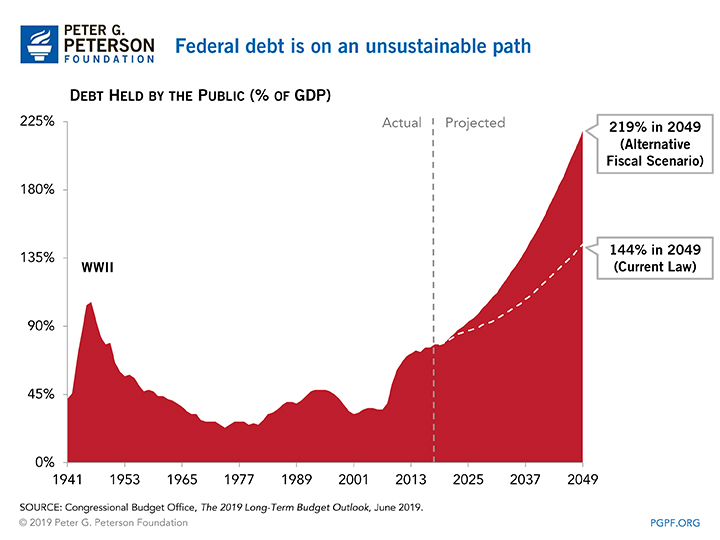
Why Is the Debt Growing?
The growth of our debt stems from a structural imbalance between spending and revenues. Under current law assumptions, CBO anticipates that federal spending will grow from 20.7 percent of GDP in 2019 to 28.2 percent in 2049. Interest alone is projected to account for 5.7 percent of GDP by 2049. Revenues are also projected to increase during that period, growing from 16.5 percent of GDP in 2019 to 19.5 percent in 2049, but not nearly enough to match the projected growth of federal spending.
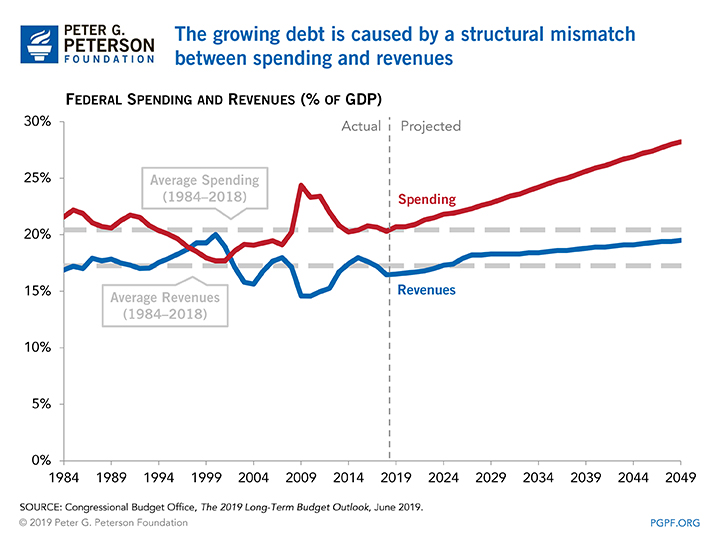
The projected increase in federal spending over the next 30 years stems from four factors:
- More than half of the increase — 3.9 percentage points — would result from increased payments for interest, which are projected to grow from 1.8 percent of GDP in 2019 to 5.7 percent in 2049.
- Medicare accounts for 3.0 percentage points of the total growth, doubling from 3.0 percent of GDP in 2019 to 6.0 percent in 2049.
- Social Security, which is currently the largest federal program, is projected to grow by 1.3 percentage points — from 4.9 percent of GDP in 2019 to 6.2 percent in 2049.
- Spending on Medicaid, the Children’s Health Insurance Program, and subsidies for the purchase of health insurance would grow by 1.0 percentage point — from 2.3 percent of GDP in 2019 to 3.3 percent in 2049.
The sum of spending on all other categories of the budget, including areas such as national defense, transportation, law enforcement, and public health research, is projected to decline relative to the size of the economy by 1.7 percentage points of GDP by 2049.
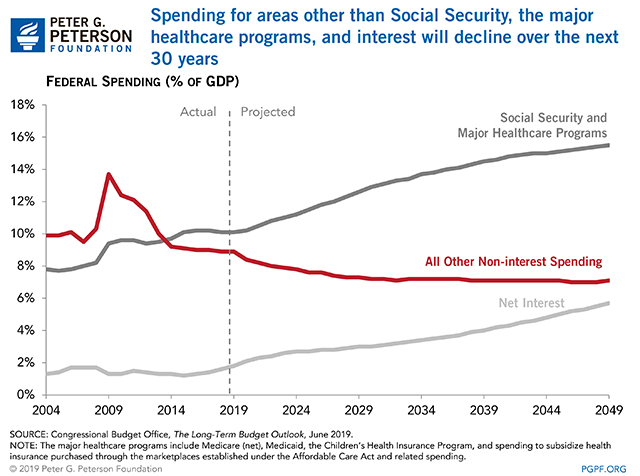
What Drives the Growth of the Largest Federal Programs?
The growth of spending on the two largest federal programs — Social Security and Medicare — is driven by two key factors: the aging of the population and increases in healthcare costs per capita. The population will age over the next 30 years as a result of baby boomers entering their retirement years and increases in life expectancy. The number of people age 65 and older is projected to increase by a staggering 57 percent, from 53 million in 2019 to 84 million in 2049. Within about 10 years, one fifth of the adult population will be 65 or older. Those trends will put significant pressure on the federal budget by driving up spending on programs that primarily serve older populations — in particular, Social Security and Medicare.
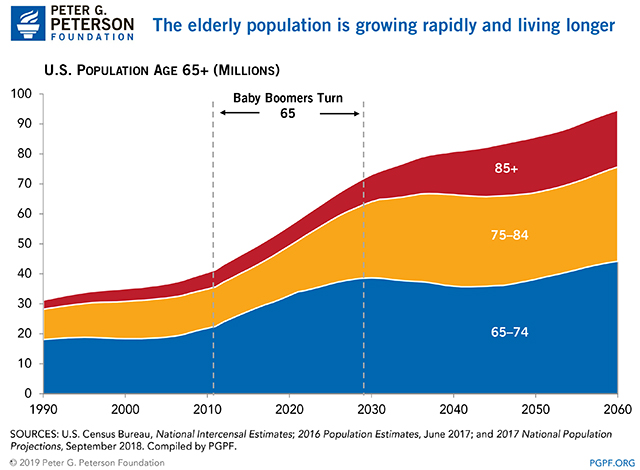
Aging accounts for almost all of the growth in spending on Social Security relative to GDP, but it is only a partial contributor to growth in spending on the government’s major healthcare programs. The largest driver for the major healthcare programs is growing healthcare costs per person. Although healthcare costs have grown less rapidly in recent years, perhaps in part due to the Great Recession, CBO projects that per-enrollee healthcare spending will continue to grow at a faster pace than GDP per capita. That “excess cost growth” will put upward cost pressure on the federal government’s major healthcare programs, accounting for about two-thirds of their growth between now and 2049.
The Growing Burden of Interest Payments
As federal debt increases, interest costs will impose a growing burden on the federal budget. CBO projects that interest payments on the debt will more than triple as a percentage of GDP between 2019 and 2049. By 2049, interest is projected to be more than 90 percent of the size of Social Security, which is the largest category in the federal budget. Because interest likely will be growing faster than Social Security at that point, it would be on a path to surpass Medicare and Social Security and become the largest category of the budget.
Mounting interest payments will crowd out our ability to fund important priorities. CBO projects that such payments will total 1.8 percent of GDP in 2019, which is more than 70 percent of what the government has historically spent on R&D, nondefense infrastructure, and education — combined. By 2023, interest costs are projected to exceed average historical spending on those investments, and by 2046, interest costs are projected to be more than double the amount historically spent in those areas as a share of GDP.
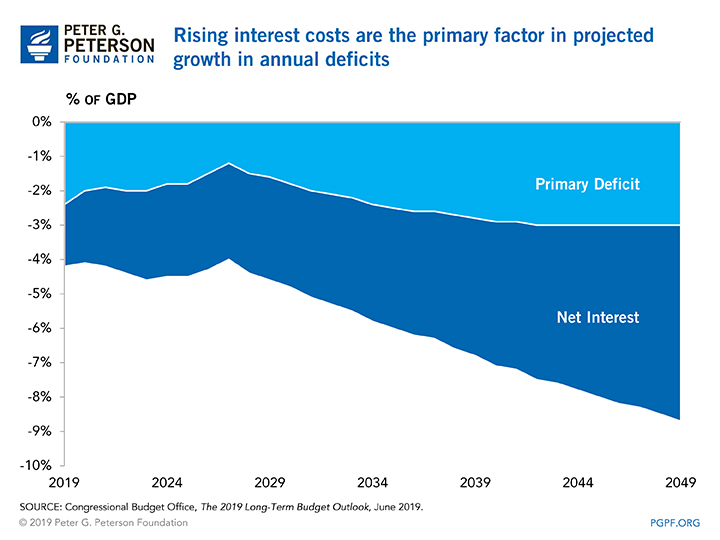
Rising National Debt Will Harm Our Economy
Absent reforms, our growing debt will have serious and far-reaching economic consequences for American families. CBO warns that increased debt would reduce future economic growth and household income, as well as draw investment away from the private sector. It could also limit flexibility for policymakers to respond to a crisis or promote economic activity. In addition, CBO points out that high and rising federal debt raises the probability of a fiscal crisis, in which investors lose confidence in the federal government’s ability to honor its obligations and proceed to demand higher yields on Treasury securities, which would cause the government’s interest costs to grow at an even faster rate than currently projected.
CBO discusses several additional negative consequences that could result from rising debt:
- Erosion of confidence in the U.S. dollar as an international reserve currency
- Concern about the value of Treasury securities and other domestic assets that might make the U.S. financial market more vulnerable
- Greater difficulty for both the government and the private sector to secure financing in international markets
- Expectations of higher rates of inflation.
Now Is the Time to Act
With federal debt on a perilous path, now is the time to make sensible decisions that will improve America’s long-term fiscal outlook. By taking action now, Congress and the President can lay a better foundation for future generations that allows greater investment, promotes stronger economic growth, and assures a more secure safety net. Taking action now would provide time for reforms to be implemented gradually, giving Americans an opportunity to adjust to the policy changes.
The longer we wait, the more difficult it will be. Under current law, CBO estimates that for federal debt in 2049 to equal its current share of GDP (78 percent), we would need to cut non-interest spending or raise revenues by 1.8 percent of GDP per year starting in 2020. However, if we wait 5 years to act, the size of these required reforms would grow by 22 percent.
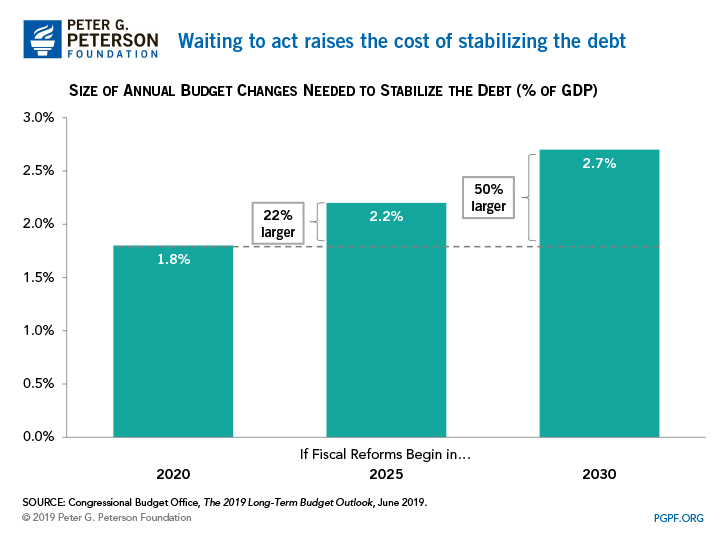
No American wants a future in which our economy is saddled with debt, starved of investment, and struggling to grow. America is facing a range of complex interconnected challenges in coming years that threaten our future. Lawmakers should chart a stable, sustainable fiscal course that enables our ability to meet these challenges, and ensure widespread prosperity and opportunity for generations to come. As CBO states:
“If policymakers understand the potential effects of high and rising debt, they may be better equipped to weigh the consequences of fiscal policy under current law against those of proposed changes to law. In all likelihood, if policymakers postponed fiscal tightening and debt as a share of GDP continued to rise, the changes necessary to stabilize debt would place an even greater burden on future generations.”
Photo by Chip Somodevilla/Getty Images
Further Reading
What Is R Versus G and Why Does It Matter for the National Debt?
The combination of higher debt levels and elevated interest rates have increased the cost of federal borrowing, prompting economists to consider the sustainability of our fiscal trajectory.
High Interest Rates Left Their Mark on the Budget
When rates increase, borrowing costs rise; unfortunately, for the fiscal bottom line, that dynamic has been playing out over the past few years.
Debt vs. Deficits: What’s the Difference?
The words debt and deficit come up frequently in debates about policy decisions. The two concepts are similar, but are often confused.

